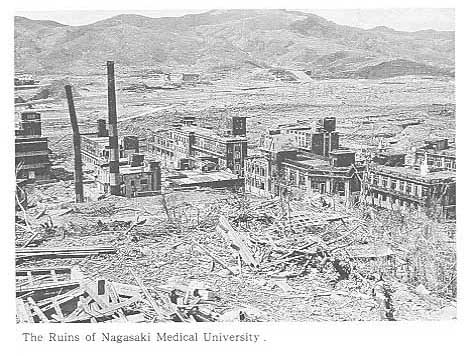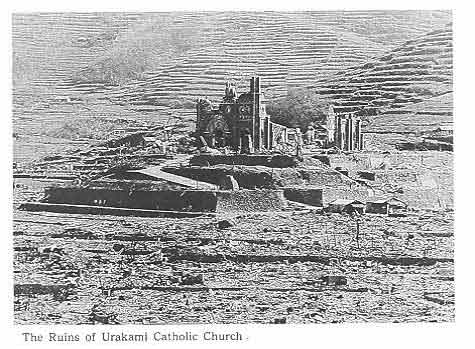A Japanese account of the Nagasaki bomb
Atomic bomb, rescue and relief report, a poignant small book, recently published in Japan, was written on the spot by Dr. Takashi Nagai, a radiologist at the University of Medicine of Nagasaki, who had participated in first aid on August 9, 1945,
This heartbreaking story, found years later, is a first-hand document, written without the comments after the event that allows the passage of time. Probably unpublished in Europe, it shows how little one knew of the radiation effects in 1945. It tells also the abnegation of rescue teams, their derisory end pathetic means.

Ruins of the Medical University
The buildings of the Medical University of Nagasaki were solid and resisted better than the surrounding houses. This is where Takashi Nagai was working at the time of the explosion and his team of the eleventh medical staff brought first aid, before going to set up on August 12 at Urakami a rescue station in the Mitsuyama valley.
© NASHIM (Nagasaki Association for Hibakushas Medical Care)
Nagasaki was bombed on August 9, 1945, three days after Hiroshima. During these three days, the population remained ignorant of what had happened to the point where teams of civil defense were completely taken by surprise: « There was a public announcement that a new type of bomb was dropped on Hiroshima, August 6, 1945, which resulted in substantial damage. Because the announcement did not offer further details, people were not prepared for the atomic bomb. Therefore, when Nagasaki was attacked with the same bomb on August 9, the military, the government, and people were caught off guard. Even though I was interested in the subject of the atomic bomb, I did not know of its existence until I saw the enemy’s propaganda leaflets scattered that night. The truth of the situation is that the entire japanese population was caught by the surprise lesson from the enemy ».
In 1945, little was known about the effects of high doses of radiations. Even a radiologist as Dr. Takashi Nagai confess his ignorance, speaking of pseudo-burns about what he observed on the victims: “Skin exposed within three kilometers of the impact showed a special kind of injury. Usually we called it a burn because the skin had received a strong heat radiation. … But we think that something other than heat rays added to the injury. My impression of the skin condition of many patients rescued immediately after the bombing gave me an impression that their injury was different from a thermal burn… This assumption is totally new. I would submit it to the criticism of my peers. Anyway, we recognized that this type of injury was more than a thermal burn. I would not just call it burn, but a pseudo-burn. « .

Ruins of the Urakami cathedral
The vicissitudes of History are such that Nagasaki has hosted the oldest Christian community of Japan, a community that had survived in hiding during the time of the shoguns. This explains the unusual presence of a cathedral among the ruins of Urakami district.
© NASHIM (Nagasaki Association for Hibakushas Medical Care)
The Nagasaki plutonium bomb was more powerful than the uranium Hiroshima’s one, but the hilly landscape made it a little less devastating. While the city before the bomb had about 210,000 people, in October 1951 there were a total of 131,050 survivors. The decision to drop the bomb was justified by the desire to save the lives of American soldiers in the event of an invasion of Japan.
The country was on its knees. The incendiary raids of B29 bombers of General Curtis Lemay on wooden houses in Tokyo have already caused 300,000 deaths. Would not a simple terrifying demonstration of the new weapon have been sufficient to establish the supremacy of the United States and obtain surrender? The hypothesis was considered but rejected. The question remains open.
Source : Atomic Bomb Rescue and Remief Report, Takashi Nagai, MD – Edited by Fidelius R.Kuo (2000)
Other articles on the subject « Military Applications »
Nuclear Weapons
Atomic and thermonuclear bombs There are two types of nuclear bombs: the atomic A bombs and the t[...]
The 1945 A-bombs
Little Boy and Fatman The United States had available three bombs in July 1945: two made of pluto[...]
The Franck Report
The Scientists who opposed dropping atomic bombs on Japan In June 1945, shortly before the atomic[...]
Nagasaki First Aid
Extracts from Doctor Takashi Nagai first report In this first rescue report intended for the auth[...]
Atoms for Peace
1953: Eisenhower’s initiative for peaceful use of the atom After the Second World War, The [...]
Testing Nuclear Weapons
A practice that culminates in the 1950’s and 1960’s… The nuclear tests conducted by the sup[...]
Atomic Tests Fallout
An embarrassing legacy but alleviated with time Radioactive fallout differ significantly accordin[...]
Arsenals reduction
A modest step towards a reduction in nuclear arsenals During the Cold War, the United States and [...]